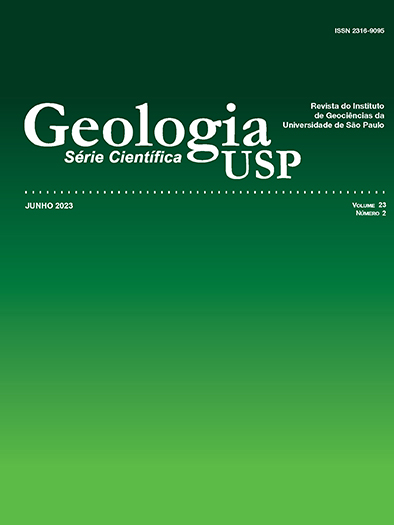Inventory of the scientific potential of the lunchboxes (weathering pits) in the district of Fazenda Nova, Pernambuco, Northeast Brazil
DOI:
https://doi.org/10.11606/issn.2316-9095.v23-204661Keywords:
Geoconservation, Geodiversity, Geoforms, Inventorying, QuantificationAbstract
Weathering pits correspond to depressions originating in granite rocks and are considered as a unit of landscape because they are existing geoforms on the surface. These geosites have a scientific value because had serve in the past as storage areas for sediments and bones of the Pleistocene megafauna, probably associated with non-functional drainage contexts under the current semi-arid climate. That way, the objective of the research was the inventory of the weathering pits located in the district of Fazenda Nova, semi-arid Pernambuco, seeking to establish indexes of its scientific potential for future policies and instruments ofmanagement of these assets at the regional level. The first stage of the inventory process was organized through a form that had the role of identifying and morphologically characterizing the distribution of weathering pits and the second was carried out following the usual method of quantification for scientific value. Considering the weathering pits presented in the context of the inventory carried out in this study, it reinforces the certainty that this heritage, considered as a geomorphosite, holds in its conjuncture the evolutionary history of the landscape diverse geomorphological
and geological information, which are pertinent information of that region, or may go beyond these contributions, because these geomorphosites have scientific value, which are correlated with several sciences, then its use can provide quite significant discoveries, regarding its scientific use.
Downloads
References
Brilha, J. (2016). Inventory and Quantitative Assessment of Geosites and Geodiversity Sites: a Review. The European Association for Conservation of the Geological Heritage. Geoheritage, 8, 119-134. https://doi.org/10.1007/s12371-014-0139-3
Gutiérrez, M. (2006). Climatic Geomorphology. Berlim: Elsevier Science & Technology, 774 p. (Developments in Earth Surface Processes, v. 8.)
Lima, G. R. (2022). Inventário geomorfológico da ocorrência de marmitas no distrito de Fazenda Nova, município de Brejo da Madre de Deus, Agreste Pernambucano. Dissertação (Mestrado). Recife: Programa de Pós-Graduação em Geografia, CFCH - Universidade Federal de Pernambuco. Disponível em: https://repositorio.ufpe.br/handle/123456789/50076. Acesso em: 27 jul. 2023.
Lopes, L. S. O. (2017). Estudo metodológico de avaliação do patrimônio geomorfológico: aplicação no litoral do estado do Piauí. Tese (Doutorado). Recife: Programa de Pós-Graduação em Geografia, CFCH - Universidade Federal de Pernambuco. Disponível em: https://repositorio.ufpe.br/handle/123456789/28468. Acesso em: 26 jul. 2023.
Neves, S. P., Mariano, G. (1997). High-K calc-alkalic plutons in northeast Brazil: Origin of the biotite diorite/quartz monzonite to granite association and implications for the evolution of the Borborema province. International Geology Review, 39(7), 621-638. https://doi.org/10.1080/00206819709465292
Neves, S. P., Mariano, G. (1999). Assessing the tectonic significance of a large-scale transcurrent shear zone system: the Pernambuco lineament, northeastern Brazil. Journal of Structural Geology, 21(10), 1369-1383. https://doi.org/10.1016/S0191-8141(99)00097-8
Neves, S. P., Vauchez, A. (1995). Magma emplacement and shear zone nucleation and development in Northeast Brazil (Fazenda Nova and Pernambuco shear zones, State of Pernambuco). Journal of South America Earth Sciences, 8(3-4), 289-298. https://doi.org/10.1016/0895-9811(95)00014-7
Panizza, M. (2001). Geomorphosites: concepts, methods and examples of geomorphological survey. Chinese Science Bulletin, 46(Supl. 1), 4-5. https://doi.org/10.1007/BF03187227
Panizza, M., Piacente, S. (2008). Geomorphosites and Geotourism. Revista Geográfica Acadêmica, 2(1), 5-9. Disponível em: https://revista.ufrr.br/rga/issue/view/175/2. Acesso em: 8 nov. 2023.
Reynard, E. (2006). Fiche d’inventaire des géomorphosites. Lausanne: Université de Lausanne, Institute Geographie. No prelo. Disponível em: https://igd.unil.ch/projrech/public/projets/87-1-161.pdf. Acesso em: 27 jul. 2023.
Silva, D. G. (2013). Reconstrução da dinâmica geomorfológica do Semiárido brasileiro no Quaternário Superior a partir de uma abordagem multiproxy. Tese (Doutorado). Recife: Universidade Federal de Pernambuco. Disponível em: https://repositorio.ufpe.br/handle/123456789/37737. Acesso em: 27 jul. 2023.
Silva, D. G., Corrêa, A. C. B., Amorim, R. F. (2017). Caracterização Morfológica e Dinâmica Ambiental das Marmitas (weathering pit) no Distrito de Fazenda Nova, Pernambuco - Nordeste do Brasil. Revista Brasileira de Geomorfologia, 18(2), 349-362. https://doi.org/10.20502/rbg.v18i2.1062
Theodossiou-Drandaki, I. R. (2000). No Conservation without Education: Key-note speech in the session for education and communication. In: Barettino, D., Wimbledon, W. A. P., Gallego, E. (eds.). Towards the balanced management and conservation of the geological heritage in the new millennium. 3rd International Symposium ProGEO - on the Conservation of the Geological Heritage. Proceedings... Madri: Instituto Tecnológico GeoMinero de España, p. 227.
Downloads
Published
Issue
Section
License
Copyright (c) 2023 Gerlando Rodrigues de Lima, Danielle Gomes da Silva Listo, Thaís de Oliveira Guimarães, Ítalo Rodrigo Paulino de Arruda

This work is licensed under a Creative Commons Attribution-NonCommercial-ShareAlike 4.0 International License.
Authors who publish in this journal shall comply with the following terms:
- Authors keep their copyright and grant to Geologia USP: Série Científica the right of first publication, with the paper under the Creative Commons BY-NC-SA license (summary of the license: https://creativecommons.org/licenses/by-nc-sa/4.0 | full text of the license: https://creativecommons.org/licenses/by-nc-sa/4.0/legalcode) that allows the non-commercial sharing of the paper and granting the proper copyrights of the first publication in this journal.
- Authors are authorized to take additional contracts separately, for non-exclusive distribution of the version of the paper published in this journal (publish in institutional repository or as a book chapter), granting the proper copyrights of first publication in this journal.
- Authors are allowed and encouraged to publish and distribute their paper online (in institutional repositories or their personal page) at any point before or during the editorial process, since this can generate productive changes as well as increase the impact and citation of the published paper (See The effect of Open Access and downloads on citation impact).





